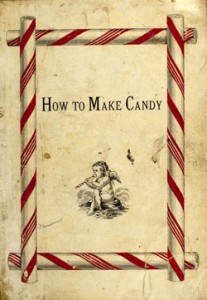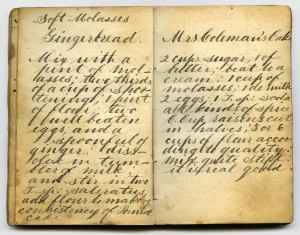Even with a month under my belt in my new job at AAS, I’m still happening upon new areas in the stacks. I’ve traveled through every main corridor many times over by this point, but am still learning about new collections down individual aisles. Just last week I learned we had a separate section just for canals. Who knew!
One of my favorite sections, however, has got to be the cookbooks. The cookbook described below was adopted by R.A. Graham Co. in honor of Ronald Ward  during AAS’s recent Adopt-A-Book event.
during AAS’s recent Adopt-A-Book event.
How to make candy: A manual of plain directions of the more popular forms of confectionery [1875].
The most recent addition to AAS’s unrivaled collection of early American cookbooks is this 168-page confectioner’s manual in its original (and delightful) illustrated wrappers. In addition to a wide range of candies, there are recipes for syrups and medicated lozenges, as well as extended discussions of flavorings and colorings. The preface states that “it is an entirely new work, written by a gentleman”—perhaps the Nathan F. Peck who copyrighted it. This is the second recorded copy of the first edition; there was also an equally rare 1876 reprinting, which AAS doesn’t have…yet.
~ David Whitesell, Curator of Books
The range of shelves devoted to the domestic art includes over 1,100 volumes, the oldest of which are foreign imprints predating American printing. The collection also includes two volumes very important to the history of the genre in America. The Compleat Housewife, published in 1742, was the first cookbook published in America, although it is a reprint of an earlier edition published in London. Another famous first in the collection is Amelia Simmons’ American Cookery (1796), which is considered the first truly American cookbook.
In addition to traditional cookbooks filled with recipes, there are also books dedicated to the joys and philosophies of eating, as well as other muses on domesticity, for it truly was difficult to separate the act of cooking from all other areas of domestic life. Hence there are wonderful books such as Modern family receipt book, containing, a great variety of valuable receipts, arranged under their respective heads, connected with the art of social and domestic life, including many valuable original communications, the result of long experience (1828). Here one not only learns how to cook, but how to do it properly and elegantly.
Cookbooks can be found not only in this range of published cookbooks, but also throughout other collections. Of particular interest is a set of handwritten cookbooks located in the manuscript collection. These manuscript volumes, dating from 1770–1899, by definition are one-of-a-kind. While the recipes don’t differ much compared to what is seen in published cookbooks (because really, there is not a huge variety of combinations one can create with the kind of ingredients that could be both acquired and kept at the time), the manuscript cookbooks are fun because of their unique prose. One can glean a feeling of community from the manuscripts recipes, especially when seeing recipes named after the women who shared them. Eating has always been a communal act, bringing people together, making people happy. It’s amazing seeing this sharing of recipes and the presumed sharing of the food that came from it.
All of this recipe reading is making me hungry, so I’m going to give one a go. In honor of the warm weather and the fast approaching summer season, I’m going to be trying out a recipe for fish chowder from Mrs. Bliss’ Practical Cook Book (1851). If anyone would like to join in the fun, here is the recipe from the pages of Mrs. Bliss’ book:

I find the mushy crackers as the thickening agent the most interesting aspect of this recipe, and am excited to see if it turns out surprisingly well or expectedly disastrous. I’ll be reporting soon on how the dish comes out.
So, one special section of the AAS stacks explored. Anyone interested in canals?


Amazing, Tracey!! I am sooooo impressed and totally envious. This all looks way too fun to be work!